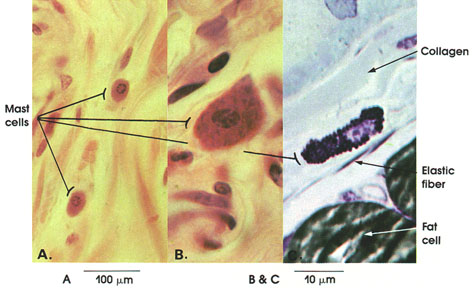

Ronald A. Bergman, Ph.D., Adel K. Afifi, M.D., Paul M. Heidger,
Jr., Ph.D.
Peer Review Status: Externally Peer Reviewed

A. Human, 10% formalin, H. & E., 162 x.
B. Rat, Helly's fluid, toluidine blue and erythrocin stains, 1416
x.
C. Rat, glutaraldehyde-osmium fixation, toluldine blue stain, 1416
x.
Mast cells are found in areolar connective tissue and along the course of small blood vessels. They have a spheroid nucleus and abundant cytoplasm. The cytoplasm is filled with coarse granules that stain red in H. & E. preparations (A), but stain metachromatically with toluidine blue and other basic aniline dyes (B and C). Granules may be so abundant as to obscure the nucleus.
In man, mast cells produce heparin, an anticoagulant substance that prevents blood clots. They also produce histamine, which increases the permeability of capillaries and influences the blood pressure.
In rats, mast cells also contain serotonin (5-hydroxytryptamine), which causes vasoconstriction and elevation of blood pressure.
Collagen and elastic fibers are scattered in the interstices between mast cells. Two fat cells stained black by osmium tetroxide fixation are seen in C.
Next Page | Previous Page | Section Top | Title Page
Please send us comments by filling out our Comment Form.
All contents copyright © 1995-2025 the Author(s) and Michael P. D'Alessandro, M.D. All rights reserved.
"Anatomy Atlases", the Anatomy Atlases logo, and "A digital library of anatomy information" are all Trademarks of Michael P. D'Alessandro, M.D.
Anatomy Atlases is funded in whole by Michael P. D'Alessandro, M.D. Advertising is not accepted.
Your personal information remains confidential and is not sold, leased, or given to any third party be they reliable or not.
The information contained in Anatomy Atlases is not a substitute for the medical care and advice of your physician. There may be variations in treatment that your physician may recommend based on individual facts and circumstances.
URL: http://www.anatomyatlases.org/